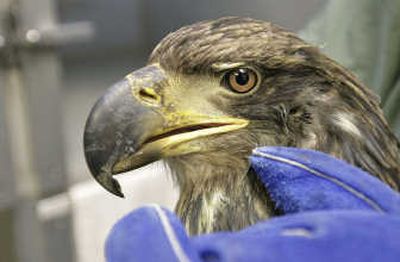WSU nurses emaciated eagles

A pair of badly ailing bald eagles have been taken in at Washington State University’s veterinary college, after being discovered separately in Stevens County during the holidays.
The eagles were found emaciated, dehydrated and starving, said Nickol Finch, veterinarian at the college’s teaching hospital.
“Quite honestly I’m glad they’re alive this morning,” she said Wednesday. “I didn’t have high hopes when I went home yesterday.”
The eagles are the latest creatures to arrive at WSU’s wildlife rehabilitation facility, which takes care of animals ranging from owls and hawks to bobcats and beavers. The new admissions are among eight eagles at the center, and Finch expects that, like virtually all eagles she sees, they’ll show evidence of lead poisoning.
“Most of the eagles we get in here have some degree of lead poisoning,” she said.
Wildlife experts aren’t sure why that’s the case – it may come from fish in polluted waterways that eagles eat or from lead shot in deer and other carrion. The two eagles brought to the WSU center this week have been tested for lead poisoning, but results aren’t in.
The birds were found separately around Christmas, said Darin Watkins, spokesman for the veterinary college. The older one, about 5 years old, was discovered sitting on Highway 395 about a mile south of Colville, Watkins said. Another one, about 3, was found near Waits Lake. The sex of the birds isn’t yet known.
The eagles first were taken to Mount Spokane Veterinary Hospital, then to WSU on Tuesday. They’re being fed and placed on IVs, along with receiving treatment for lead poisoning and anti-fungal medication, Finch said.
Most creatures that wind up at the rehab center never see the wild again, either because they die or are too badly injured or sick to survive.
But the center has released some eagles after several months of rest and recuperation, Watkins said.
“We had a number of releases last year in cases similar to this,” he said.